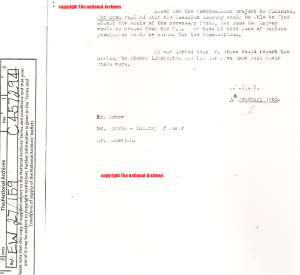CHEMICAL WEAPONS EXPERIMENTORS
“On strategic requirements, Mr Carter said that in world War II they had supplied large quantities of phosphorus for smoke shells and grenades, and were still supplying 180,000 lbs/year to the ROF at Bridgend. Phosphides were needed for mariners, and a small but important use was the manufacture of nerve gases.”
This direct quote comes from The future of phosphorus manufacture- a document held at the National Archives. At this time Albright and Wilson were in the process of considering a move to Newfoundland, which was to change the face of producing white phosphorus in the UK. The meeting note below shows those present, which was held on 4th February 1966. Note the date, as it is important.
©The national archives, reproduced by permission to
http://whatliesbeneathrattlechainlagoon.org.uk/
Present at this meeting representing Albright and Wilson were W. Carter and Owen Wansbrough –Jones who in 1940 was commissioned into the royal engineers, rising to the rank of brigadier in 1945. In the British army he specialised in chemical and biological warfare and also became the “director of Special weapons and vehicles” in the Ministry of Supply in 1946.
After a series of advisory and administrative posts, he was appointed chief scientist to the ministry of supply in 1953, until he retired in 1959. He was knighted in 1955.
His next job, a seamless transition in 1959 was as technical advisor to Albright and Wilson- a military supplier of phosphorus both during and after the war. He was later to become executive vice- chairman and eventually chairman of the military supplier.
Carter’s summary of a use for phosphorus being in the manufacture of phosphides in preparations for nerve agents perhaps shows what was really happening with this companies supply to the British Government during the cold war. ROF Bridgend is officially listed as closing in 1946- so why 20 years later are 180,000lbs of white phosphorus still being supplied here by Albright and Wilson? What was really going on in the underground Welsh station? What was Albright and Wilson’s role in the manufacture of nerve agents- at a time when a man in the form of Wansbrough-Jones was a former chief expert on the subject for the British Government? These are uncomfortable questions- but show just how joined at the hip this company was at this time with the British state- and especially with the Ox-bridge university institutions. Employing a top former military man would benefit the procurement process- his contacts would be second to none.
Given the lack of information concerning the Second World War wartime “works tip” at Albright and Wilson’s Langley factory, mentioned in passing in “100 years of phosphorus making” by R.E Threlfall, it is worrying to note other toxic chemicals being manufactured at the site around the same period and more importantly how the “waste” from these processes was being disposed of in a time before any regulation.
An article from Sept 4th 1989 edition of Chemistry and Industry by Stanley Wilson, (who joined the company in 1937) provides more worrying information concerning Albright and Wilson’s Research and Development Department at Oldbury. He gives reference to the captured German “godfather” of nerve agents Gerhard Shrader, who found the lethal nerve agent tabun, and later sarin during wartime experiments. The so called “Allies” were keen to interview him and it appears that a race between the victors of war led to a new laboratory war to devise a new more lethal series of nerve agents- all derived from phosphorus chemistry.
The US Environmental Protection Agency take up the story in a document concerning the analysis of their degredation products.
From the abstract
“On 11 May 1943, the British captured a German chemist who had worked at the main Army CW research laboratory in Spandau. The prisoner told the British the code name for Tabun (Trilon 83), the chemical reactions by which it was produced, its effects, and methods of use and defense against Tabun. This was compiled into an MI-9 intelligence report of 3July1943. Following the war, the Allies contended that they first became aware of Tabun in April 1945, when a German ammunition dump was captured and a shell containing Tabun was shipped to the United Kingdom for analysis. However, the record appears to show that the 1943 report was ignored.”
Ultimately for Britain this culminated in the scandalous Porton Down experiments. In 1953 airman Ronald Madison died after being subjected to nerve gas.
Wansborough -Jones must have played a key role in these experiments given his position at this time. But what role did Oldbury play in the development of potential nerve agents ?In Wilson’s article:
“In retrospect, a botched 1938 pilot batch of tri-isopropyl phosphate had caused transient acute respiratory effects on operators but no avenue existed then for follow-up. The firm, quick now to respond, and approaching with proper precautions became a leader in the pesticides field.”
Albright and Wilson products included many lethal acids and the powerful organo-phosphate insecticide Malathion. It is probable that the junk from their experimenting was conveniently dumped, with state sponsored anonymity and deniability.
A former site worker called John Howard Steiner has commented on an internet published account : “that it was a firm owned by Quakers did not stop it being a principal supplier of phosgene poison gas during the 14/18 war, and perhaps also in the last war.”
It was Sir Richard Threlfall (R.E Thelfall’s father and both Cambridge educated), that was responsible for pioneering the manufacture of this weapon of mass destruction at Albright and Wilson at Oldbury in the First World War where they also manufactured mustard gas, in addition to phosphorus smoke screens. But what was done with the waste stream of this process, and the contaminated machinery that made it; did it go to “the works tip”?



